
|
Sale 51
Pre-Long Beach Coin and Currency Auction
| Lot |
Photo |
Description |
Realized |
Lot 1407 |
 |
1854 $3 Gold. PCGS graded Proof 63 Cameo. Exquisite rich golden overtones on both sides. We note a few scattered fly-specks on both sides. Only 15 Proofs struck. Extremely rare in Proof. In its auction appearance in a January 2007 Heritage sale, the cataloger described the surface condition as follows: "The present example offers luscious orange-gold fields with considerable contrast present. The S in STATES is lower than the E, without the deeply impressed lettering characteristic of the other Proof die. A couple of light scrapes are noted on Liberty's cheek, and a couple of dark toning spots on the obverse: one in back of the eye, and one behind the headdress. On the reverse a similar dark spot occurs at the bottom of the 1, and a patch of light yellow-gold patina is noted through DO in DOLLARS. A delectable early Proof example of this historic and unusual denomination."
It appears two different pairs of Proof dies were used to strike Proofs in 1854. One has the ES in STATES on a level curve, and the lettering is deeply impressed into the die. On this piece from the second die, the S is slightly lower than the E, with the lettering not as deep. Although the exact number of Proof 1854 $3 survivors remains to be enumerated, there is no doubt that this issue is exceedingly rare. In fact, this is the finest specimen that we have been privileged to offer. Pop 2; 2 finer in 64 (PCGS # 88017) .
Estimated Value $70,000 - 80,000.
From The Dr. Robert J. Loewinger Collection.
View details and enlarged photos
Check results on similar lots
| Unsold |
Lot 1408 |
 |
1854 $3 Gold. NGC graded AU-58. Untoned. A frosty example with remnants of luster around the legends and devices. A strong first-year strike brings out the fullness of strike and eye appeal of this interesting design.
The handsome Longacre first "cereal wreath" which is used on the flying eagle cents, the gold dollars (type 2 and 3) as well as this $3 gold piece, is comprised of corn, wheat, cotton and tobacco. His second wreath, used on numerous pattern coins as well as the half dimes and dimes during his tenure in office, is comprised of cotton, tobacco, sugar cane, corn, wheat and oak leaves. This is the first design of a cereal wreath created by the Mint's chief engraver, 1844-69.
In a new 4 prong NGC holder. 138,618 struck (PCGS # 7969) .
Estimated Value $1,700 - 1,800.
View details and enlarged photos
Check results on similar lots
| Realized
$1,725 |
Lot 1409 |
 |
1856 $3 Gold. NGC graded AU-58. Nice light golden toning. A lustrous pale lustrous AU with frostiness within the devices. A hint of weakness at the lowest hair waves and correspondingly at the wreath bow, The feather puffs, however, display their detail. In a new NGC 4 prong holder. 26,010 pieces struck (PCGS # 7974) .
Estimated Value $2,000 - 2,200.
View details and enlarged photos
Check results on similar lots
| Realized
$2,300 |
Lot 1410 |
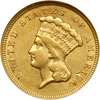 |
1856 $3 Gold. NGC graded EF-40. Untoned with light, even wear on the high points. Smooth surfaces barring a little dent below C on the obverse (PCGS # 7974) .
Estimated Value $1,000 - 1,100.
View details and enlarged photos
Check results on similar lots
| Realized
$1,150 |
Lot 1411 |
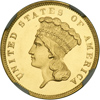 |
1859 $3 Gold. NGC graded Proof 65 Ultra Cameo. A dazzling bright and untoned Ultra Cameo Gem of this early "Indian Princess" $3! This issue is the first in the Proof Three-dollar series for which the Guide Book lists a mintage figure. A total of 80 pieces struck is reported in federal archives, but it seems absurd that all of these coins were distributed by year's end considering the meager number of auction appearances (see census below). Mint Director Colonel James Ross Snowden's campaign to market Proofs to collectors was in its formative period, and we agree with Bowers and Winter that upwards of two-thirds of the original mintage may have been melted as unsold. Today, possibly a dozen Proof 1859 $3 gold pieces are believed to exist, the present sparkling Gem Proof 65 certainly one of the most appealing.
Both sides are nicely frosted in finish with sleek, reflective fields supporting the bold devices. Even yellow-gold color throughout, there are no blemishes that are worthy of note. Pedigree concerns alone cause us to mention a tiny spot in the field below the letter U in UNITED. With solid technical merits and infinite eye appeal, this coin could easily become a showpiece in an advanced Type collection of U.S. gold, or, if the challenge be taken, in an even more advanced Proof date collection of $3 gold! Pop 2; none finer at NGC. No Deep Cameos at PCGS for this date.
Estimated Value $60,000 - 70,000.
View details and enlarged photos
| Realized
$57,500 |
Lot 1412 |
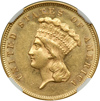 |
1859 $3 Gold. NGC graded MS-60. A nice untoned example with semi reflective surfaces in a new NGC holder with 4 prongs. A Mint quality example with muted luster that graces the frosty pale golden devices. Nicely struck for an 1859 $3, indeed, about as fine as this date is ever found. James B. Longacre would have loved this one! Only 15,558 pieces struck. Pop 7; 96 finer. (PCGS # 7979) .
Estimated Value $2,500 - 2,700.
View details and enlarged photos
Check results on similar lots
| Realized
$2,875 |
Lot 1413 |
 |
1866 $3 Gold. PCGS graded MS-66. Here is a blazer! A superb well struck gem exhibiting a mixture of satiny and semi prooflike surfaces. Mintage of only 4000. The 1866 $3 gold coin, of which a minuscule few thousand circulation strikes were made, is another entry in the list of classic rarities from this decade. We estimate no more than 150 to 200 circulated pieces exist, to which can be added 25 to 40 in Mint condition. Among the Mint State survivors this is by far of the finest certified, earning an impressive Mint State 66 designation from PCGS (serial #21726156). Two known in this grade. It would be impossible to imagine even one more like it. Impossible it would be to expect one finer! A coin bearing such credentials as this makes us hold our breath to reflect how remarkable the coin really is. If ever a buyer seeking a "trophy" coin should want to pounce, this is the coin he'd choose. Many will be attracted by its high grade, rarity, and beauty. This offering translates into a remarkable opportunity! Pop 2; none finer at either service. Tied for finest known business strike (PCGS # 7987) .
The year 1866: The first big cattle drive took place this year as "cow-boys" as they were called drove 260,000 head from Texas to the meat packing plants of Kansas, Missouri, and Iowa. In the next 20 years, between 4 and 8 million cattle were driven north. This practice was hotly opposed by Indians and farmers who lived en route, and many battles took place. (After Philip Armour opened his meat packing plant in Chicago after the Civil War, cattle could be sold to northern markets for as much as $40 per head, making it potentially profitable for cattle, particularly from Texas, to be herded long distances to market.).
Estimated Value $45,000 - 50,000.
View details and enlarged photos
Check results on similar lots
| Realized
$40,250 |
Lot 1414 |
 |
1868 $3 Gold. NGC graded AU-53. Light golden toning with traces of luster still adhering to the protected areas. Only 4,850 struck. Pop 24 (PCGS # 7989) .
Estimated Value $1,500 - 1,600.
View details and enlarged photos
Check results on similar lots
| Unsold |
Lot 1415 |
 |
1869 $3 Gold. NGC graded Proof 65 Ultra Cameo. A full blazing untoned Ultra Cameo Gem Proof specimen. Only 25 Proofs struck. This is an amazing representative of this exceedingly rare issue, and it is the only Ultra or Deep Cameo specimen known to the two major grading services. Fully struck, satin-textured devices appear to float atop deep pools of mirrored reflectivity in the fields. The delicate surfaces have obviously been well cared for since the day of issue, and an even endowment of warm yellow-gold color is also a praiseworthy attribute.
As with the Proof 1868, the 1869 has an original mintage of a mere 25 coins. Of this already limited total, only 12 or perhaps 14 pieces have survived, including several held in museum collections. For the collector or investor seeking a truly rare coin, the Proof 1869 Three-Dollar gold piece comes highly recommended.
Simply put, all Proof Three-Dollar gold pieces are rare coins. Some are exceedingly so, such as the pre-1859 issues which were produced in unknown, although presumably extremely limited quantities. Two, the 1875 and 1876, enjoy heightened demand from date collectors as Proof-only deliveries. Others are the focus of nearly the same degree of buyer attention due to paltry original mintages for their identically dated business strike counterparts. Examples from this final group include the 1881, 1883 and 1885. As for the remaining issues, none can even be remotely described as common. In fact, the most frequently encountered Proof Three in today's market, the 1888, has an extant population of fewer than 150 coins -- definitely a limited total when viewed in the wider context of numismatics. Pop 1; finest graded and the only graded Ultra Cameo at either service. Here is a candidate for finest known. (PCGS # 98032) .
Historic note: The origins of this odd denomination stretch all the way back to 1832, when Representative Campbell P. White of New York introduced a bill calling for minting of a three-dollar gold piece with a weight of 75 grains. The bill never reached a vote, however, and it would be several years before the federal government returned to the idea of authorizing a three-dollar gold piece. In 1851, Congress reduced the postal letter rate to three cents while simultaneously authorizing the Mint to strike three-cent pieces in low-fineness silver to expedite purchase of stamps. The Mint Act of February 21, 1853, while best known for reducing the weight of most silver coins and adding arrows at both sides of their dates, also included a clause authorizing production of a three-dollar gold piece. Apparently, Congressional leaders anticipated that this denomination would expedite exchange of three-cent silver rolls and/or purchase of full sheets of three-cent stamps. Business strikes and Proofs were produced every year from 1854 through 1889 with the exception of 1875 and 1876, when only Proofs were struck.
Estimated Value $50,000 - 55,000.
View details and enlarged photos
Check results on similar lots
| Realized
$57,500 |
Lot 1416 |
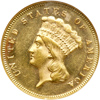 |
1872 $3 Gold. NGC graded MS-62 Prooflike. Beautiful prooflike surfaces. Clearly superior to the vast majority of heavily abraded About Uncirculated to low-end Uncirculated pieces, this choice reddish-golden example has only a few well scattered hairlines and benefits from the high production standards employed by the Mint during the decade of the 1870s. Excellent detail with perhaps minor weakness to the feather puffs and, as always on $3 business strikes, softness on the ribbon bow on the reverse. A scarce low mintage date. Only 2,000 struck. Pop 3; 1 finer in 63.
Estimated Value $6,000 - 6,500.
View details and enlarged photos
| Realized
$7,475 |
Lot 1417 |
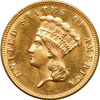 |
1874 $3 Gold. AU-58. Well struck and lightly toned with semi reflective fields. We note a few minor hairlines scattered about. A high grade and very desirable example for a type set.
James B. Longacre's "Indian Princess" head is one of several he modeled on the Greco-Roman Venus Accroupie profile which had already served for the gold dollar and double eagle, and, from 1854 to 1889, this $3 gold piece. The feathered headdress is supposed to emphasize "national character."
Estimated Value $1,700 - 1,800.
View details and enlarged photos
| Unsold |
Lot 1418 |
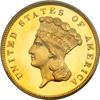 |
1876 $3 Gold. PCGS graded Proof 65 Deep Cameo. A dazzling gem Proof whose deep mirror surfaces are enhanced in a welcoming way by the lovely delicate golden sunset toning. In our Ohringer Part II Sale, Sept. 2008, lot 1240, an 1876 in PCGS Proof 65 Cameo realized $92,000. This example is finer and has the "DCAM" designation. Only 45 reported struck for this proof only year.
The Proof-only 1876 $3 gold piece is made famous by its low mintage and similarly low survival, with possibly as few as 25 to 30 believed extant. It is in the company of several other distinguished rare Proof dates in the $3 series including the Proofs of 1861, 1874, and 1878, but with the proviso that these other issues are not the desirable Proof-only years.
Point your vision in the direction indicated and enjoy the beauty of this remarkable coin as we guide you step by step through its endless virtues: Glowing luster with crisp definition and exceptionally clean surfaces. Strong cameo contrast on both sides. Identifiable by a tiny flake a little distance below the D in UNITED and another tiny imperfection above the 8 in the date, both of which are inconsequential. Definitely, a premium example of the grade. In fact, the defining Cameo Proof 65 $3 gold coin! Adding to those results, a further word about strike: this piece has needle-sharp devices, with impressive detail on the headband "pears," as they are sometimes called (the feathered headdress itself), with all hair waves complete, and throughout the Wreath of Cereals made famous in American numismatics by the artist and mint engraver who created it, James B. Longacre.
A thin veil of toning is seen on both sides. Among the most massively attractive Gem Cameo Proof 1876 three-dollar gold pieces that bidders will ever see presented for sale. Pop 4; 1 finer in 66 (PCGS # 98040) .
Estimated Value $90,000 - 100,000.
View details and enlarged photos
Check results on similar lots
| Realized
$86,250 |
Lot 1419 |
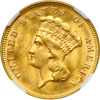 |
1878 $3 Gold. NGC graded MS-65. A lovely lustrous specimen shimmering with mint frost. An ideal coin for a gem quality 12 piece type set. The resplendent example offered here not only surpasses the normally seen luster woes, but its sparkling surfaces border on an even higher grade. In fact, only scattered tiny marks can be seen with the aid of magnification. Struck with systematic exactness throughout excepting the usual weak areas at the ribbon bow of the wreath along a few topmost hair curls worn by Liberty (PCGS # 8000) .
Estimated Value $17,000 - 18,000.
View details and enlarged photos
Check results on similar lots
| Unsold |
Lot 1420 |
 |
1878 $3 Gold. NGC graded MS-62. A fully lustrous example with excellent surfaces throughout. The bright gold color erupts everywhere untouched by toning. A decent strike as well, making this an advantageous coin for the focused collector and an ideal coin for a Mint State gold type set (PCGS # 8000) .
Estimated Value $3,300 - 3,500.
View details and enlarged photos
Check results on similar lots
| Unsold |
Lot 1421 |
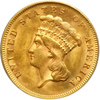 |
1878 $3 Gold. PCGS graded MS-62. Nice and frosty with rich undistrubed mint bloom colors. A total of 82,304 coins were minted.
The $3 gold piece was authorized by the Act of February 21, 1853, a very important piece of legislation from a numismatic viewpoint, an act which also affected the silver coinage, namely the reduction in weight of the half dime, dime, quarter, and half dollar, and the addition of arrows alongside the date to indicate the new standard. Whether or not the $3 denomination was actually necessary or worthwhile has been a matter of debate among numismatists for well over a century. At the time of its introduction, 1854, the $3 had as a close companion-the long established $2.50 quarter eagle (PCGS # 8000) .
Estimated Value $3,300 - 3,500.
View details and enlarged photos
Check results on similar lots
| Realized
$3,565 |
Lot 1422 |
 |
1878 $3 Gold. NGC graded AU-58. A hint of light gold tone. Frosty and attractive. Only 82,304 pieces minted (PCGS # 8000) .
Estimated Value $1,500 - 1,600.
View details and enlarged photos
Check results on similar lots
| Realized
$1,639 |
Lot 1423 |
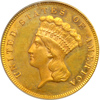 |
1879 $3 Gold. PCGS graded MS-61. Old green holder. Nice golden toning with reflective surfaces. Smooth luster spins broadly beneath naturally toned gold highlights. The reverse strike at ribbon is nearly complete in detail, making the present specimen somewhat above average where design definition is concerned. 3,000 minted (PCGS # 8001) .
Estimated Value $3,200 - 3,500.
View details and enlarged photos
Check results on similar lots
| Realized
$3,335 |
Lot 1424 |
 |
1880 $3 Gold. NGC graded Proof 65 Cameo. Brilliant gem Proof coin in a new NGC 4 prong holder. This 1880 three dollar gold Proof boasts a limitless virtues on top of a low mintage of 1,000 business strikes and just 36 Proofs. A beautiful premium Gem, it exhibits needle-sharp design details and sleek, reflective fields. A lovely cameo effect is achieved on both obverse and reverse, the result of the inner recesses of the dies being left in their frosted state when the surface of the die (which became the surface of the struck coin) got its mirror polish by the die preparer. The surfaces exhibit dominant brilliant-gold color. There are no vexing contact marks or haziness noted, everything bright and gleaming. Certainly one of the more impressive Gem Proof survivors of this extremely low mintage issue. Pop 3; 2 finer; 1 in 66; 1 in 67. (PCGS # 88044) .
The new $3 denomination was designed by James B. Longacre, who became chief engraver at the Mint in 1844, after the death of Christian Gobrecht. The obverse features the head of an Indian princess, facing left, wearing a feathered headdress upon which is a band inscribed LIBERTY. The inscription UNITED STATES OF AMERICA surrounds. The same motif was later used on the Type III gold dollar 1856-1889. Proofs were made in every year from 1854 to 1889, although it is something of a challenge of Job to acquire a complete set!
Estimated Value $22,000 - 24,000.
View details and enlarged photos
Check results on similar lots
| Realized
$25,300 |
Lot 1425 |
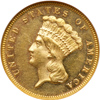 |
1882 $3 Gold. NGC graded MS-62 Prooflike. A nice untoned example with prooflike surfaces. Popular low mintage date. Unrivaled for an MS62 in terms of exterior preservation, both sides of this golden beauty are well frosted on the devices and for all intents and purposes tone-free. Only scattered hairlines. Somewhat soft strike in areas, possibly pointing to a worn master hub. Only 1,500 struck. Pop 3; 7 finer; 1 in 63; 2 in 64; 3 in 65; 1 in 66 Star.
Estimated Value $5,000 - 5,500.
View details and enlarged photos
| Realized
$5,520 |
Lot 1426 |
 |
1884 $3 Gold. PCGS graded Proof 64 Deep Cameo. A gorgeous golden-orange brilliant Proof example with deeply frosted devices as recognized by PCGS and noted on the holder. One of a pair of glowing Proof 64 examples of this date consigned to a sale by our consignor. Across most grades, the 1884 is relatively available in Proof format, though collector demand regularly trumps supply. That is not to say a coin of this caliber is common. Not by any means. It is genuinely rare, with only a small number graded by the two chief grading services.
This is a particularly splendid specimen, the present coin. Its reflective mirrored fields are delicately tinted with hints of color, the devices nicely frosted; impressed devices are bold. Excellent contrast conveyed by these opposing qualities for a Proof, and pleasing beyond reproach, thereby desirable as such. Only 106 struck. Pop 2; 1 in 65 DCAM, 1 in 66 DCAM, 1 in 67 DCAM (PCGS # 98048) .
Estimated Value $17,000 - 18,000.
View details and enlarged photos
Check results on similar lots
| Realized
$16,675 |
Lot 1427 |
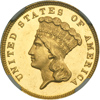 |
1888 $3 Gold. NGC graded Proof 64 Ultra Cameo. Mostly untoned. An exquisitely struck near-Gem of this later issue, one whose imposing cameo contrast rises in majestic relief against the reflective fields. Bright and free from copper stains, the golden color dances around the surface on both sides. A few faint hairlines are present. Proofs of this date tend to be well made, anyway, and exhibit cameo to ultra cameo contrast against the polished-die fields which creates the Proof surface during production. To insure the customer's satisfaction, the Mint made an effort to strike Proof coins twice with the dies, which is a marked improvement over business strike coins where soft-edged lettering and devices are more the norm. Only 291 Proofs struck. Population 1; none finer at NGC.
Estimated Value $17,000 - 18,000.
View details and enlarged photos
| Realized
$19,550 |
Lot 1428 |
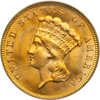 |
1889 $3 Gold. PCGS graded MS-66. A well struck gem example exhibiting full rich mint bloom colors. Popular last year of issue and only 2300 minted. A entirely lustrous example whose bright golden brilliance whirls dizzily around the surface. And as if that weren't enough to entice bids out of even the most inflexible buyer, this piece is also about as fully struck as these are normally found, with just terrific detail in the hair and feathers, the leaves in the wreath and all letters in the legends. A sterling example! Pop 10; 2 in 67 (PCGS # 8011) .
The $3 denomination was designed by James B. Longacre, who became chief engraver at the Mint in 1844, after the death of Christian Gobrecht. The obverse features the head of an Indian princess, facing left, wearing a feathered headdress upon which is a band inscribed LIBERTY. The inscription UNITED STATES OF AMERICA surrounds. The same motif was later used on the Type III gold dollar 1856-1889.
The coinage act of 1890 called for the prohibition of the minting of the three-dollar gold piece, stating, "the piece shall not be struck or issued by the Mint of the United States." The provisions of the act also stipulated that the current circulation of the coins was to be called in and withdrawn and that "all laws and parts of laws in conflict with this act are hereby repealed."
Essentially, not only did this act demonetize the three-dollar (along with the gold dollar), but it also repealed and ended the gold dollar as being "the unit of value", or statutory standard of the monetary system of coinage -- hence ending the short lived "gold standard", as declared in the coinage act of 1873.
Estimated Value $22,000 - 24,000.
View details and enlarged photos
Check results on similar lots
| Realized
$21,850 |
Lot 1429 |
 |
1889 $3 Gold. NGC graded MS-66. Only 2,300 pieces minted. A nice untoned coin housed in the new NGC 4 prong holder. Loaded with gem luster. This is a lovely, healthy-glowing specimen, one whose full-color obverse and reverse being essentially untoned, beams with frosty luster. All this is perhaps obvious from the photos. What we need to emphasize also is that the strike is customarily crisp and detailed for the 1889 release, the last year of issue, with the usual sharp metal flows into the deepest recesses of the dies on both sides including full plumes on Liberty's feather headdress. Pop 8; none finer at NGC (PCGS # 8011) .
Estimated Value $22,000 - 24,000.
View details and enlarged photos
Check results on similar lots
| Unsold |
Lot 1430 |
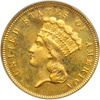 |
1889 $3 Gold. PCGS graded Proof 64. Old green holder. Nice golden toning. A very beautiful example of the date. Hazy natural patina with rippling underlying mirror surface. The devices are delicately frosted and mirrors are deep enough under the layer of color to approach what today's generation calls "scrumptious" when describing vivid originality such as offered here. One glance at this choice lovely Proof should convince you that you need search no higher up the grading scale to obtain a splendid Proof of the date. Take our word for it, you'll be hard pressed to find a more beautiful Proof 1889 $3 in this grade from any grading service. Only 129 struck. Pop 40; 7 finer; 4 in 65; 3 in 66. (PCGS # 8053) .
Experienced collectors are of course familiar with the strange $3 gold denomination. Coinage of this all-but-forgotten coin came to a close with the Coinage Act of 1890; the same Act doing away with two other superfluous denominations, the gold dollar and three-cent nickel.
Estimated Value $13,000 - 14,000.
View details and enlarged photos
Check results on similar lots
| Realized
$12,650 |
|
|